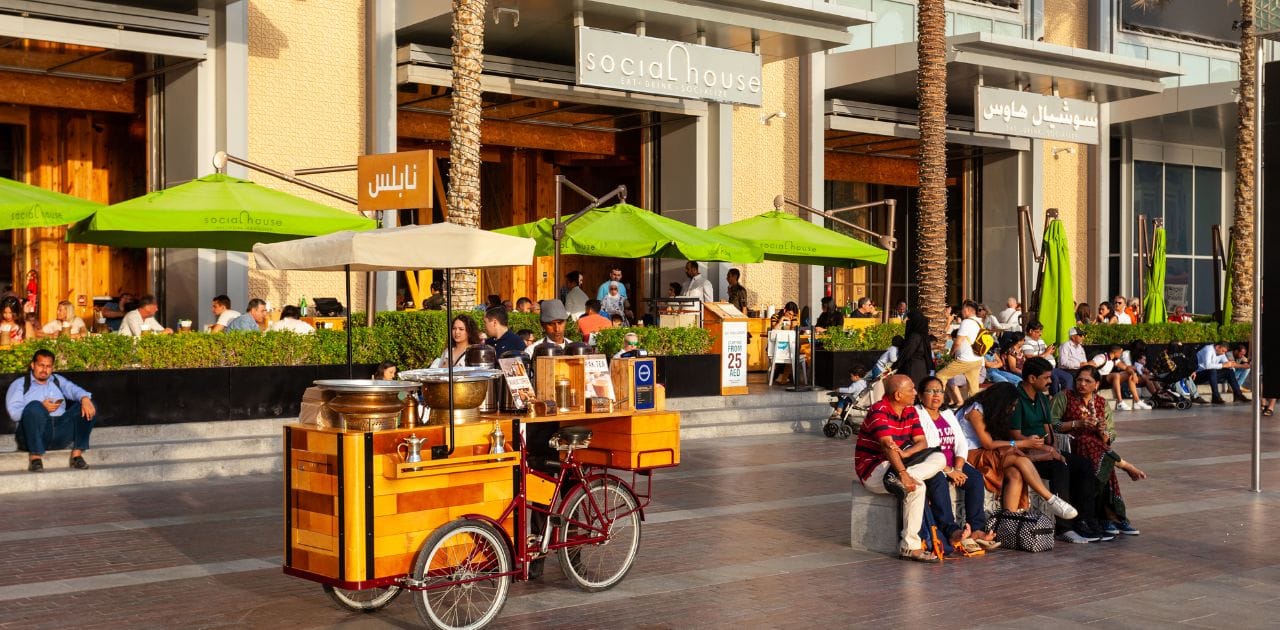So, you’ve landed in Dubai and you’re already thinking about food, right? Honestly, nobody’s blaming you. Dubai isn’t just about luxury hotels or fine dining on rooftops. The real fun begins when you step into its food streets. Street food here is like a crash course in the city’s culture, quick, bold, and unforgettable.
Now, you might be surprised to know this: nearly 90% of Dubai’s population are expats. That means when you grab a quick bite, you’re tasting flavors from India, Pakistan, Lebanon, Iran, the Philippines, and, of course, traditional Emirati dishes too. Can you imagine how much variety that adds to the Dubai food scene? It’s literally like eating your way around the world without leaving the city.
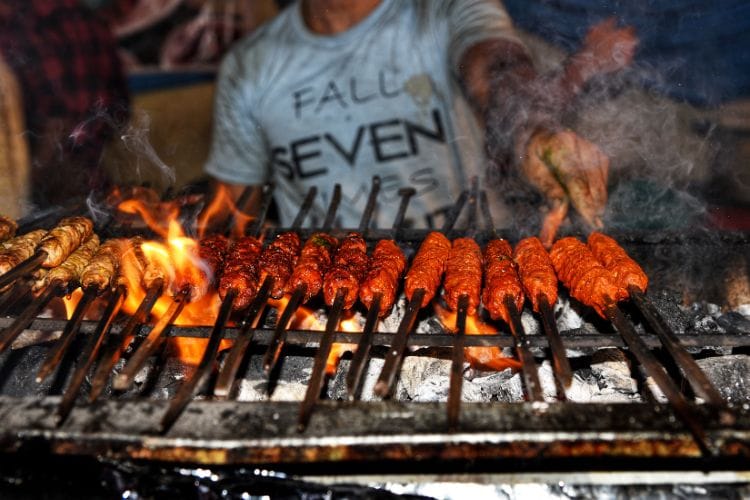
Why Try Dubai Street Food (or How It Evolved)
Here’s what people think, you can’t say you’ve “really” experienced Dubai until you’ve tried its street food. Why? Because that’s where you meet the real city. Forget the gold-plated cappuccinos; this is food made by locals, for locals, and served with zero pretense.
A few decades ago, the story was different. Street food in Dubai meant Emirati snacks at souks or simple tea stalls. Then came the migrant workers from South Asia, the Levant, and beyond. They brought their spices, breads, and grills, which blended with Emirati traditions. Fast forward to today, and you’ve got a mix of Middle Eastern street eats, South Asian bites, and Emirati snacks, all coexisting.
So, whether you’re in Deira munching on shawarma, or in Karama sipping on karak chai, you’re tasting a little history. And the best part? It’s affordable. Most dishes cost between AED 5–15 ($1.30–$4). Compare that to a high-end brunch, and you’ll see why locals swear by it.
Best Dubai Street Food to Try
Now comes the fun part, the food itself. Let’s break it down into the stuff you absolutely shouldn’t miss.
Shawarma
Okay, let’s start with the king of street food in Dubai: shawarma. Imagine juicy grilled chicken or beef, shaved off a rotating spit, tucked into warm pita, and loaded with garlic sauce, pickles, and sometimes even fries. Simple, but so good. You’ll see shawarma stands almost everywhere. And guess what? They’re usually under AED 10 ($2.70). Cheap, filling, and addictive.
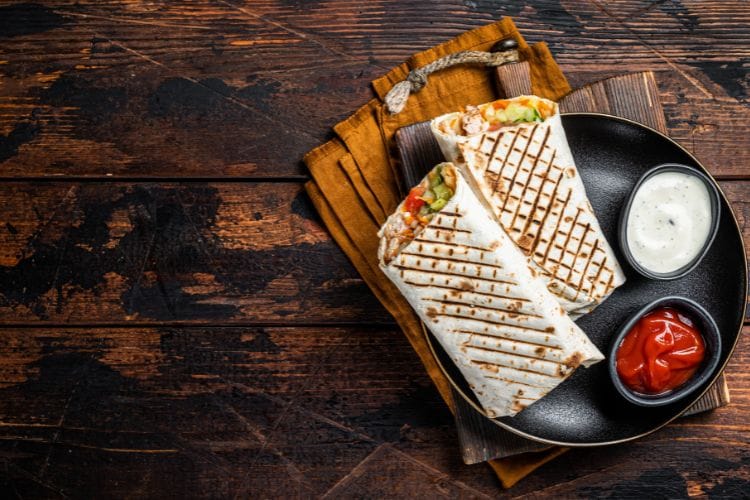
Falafel
Falafel is basically chickpeas turned into little golden balls of goodness. Crunchy outside, soft inside, and usually paired with tahini sauce or tucked into a wrap. If you’re vegetarian (or just want something light), this is your go-to. Plus, it’s one of those snacks that has stood the test of time, people in the Middle East have been eating falafel for centuries.
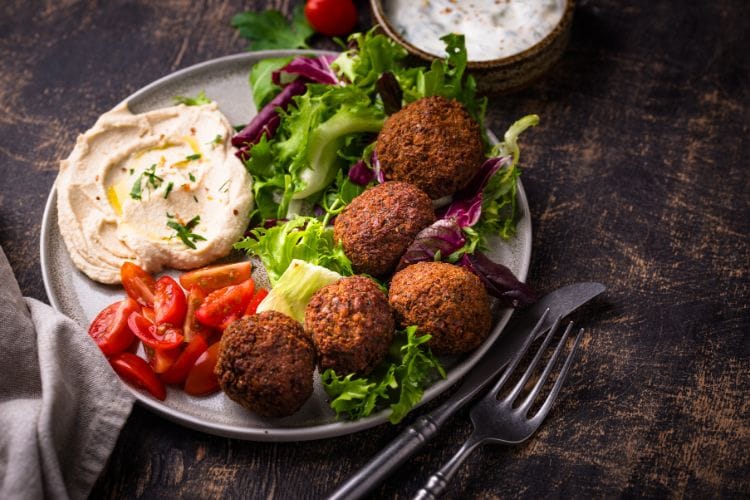
Samboosa
You might know this as a samosa, but in Dubai, it’s called samboosa. This fried triangle of pastry can be stuffed with potatoes, spiced meat, or even cheese. During Ramadan, they’re everywhere, but you’ll still find them year-round at South Asian stalls in Deira and Karama. Small snack, big flavor.
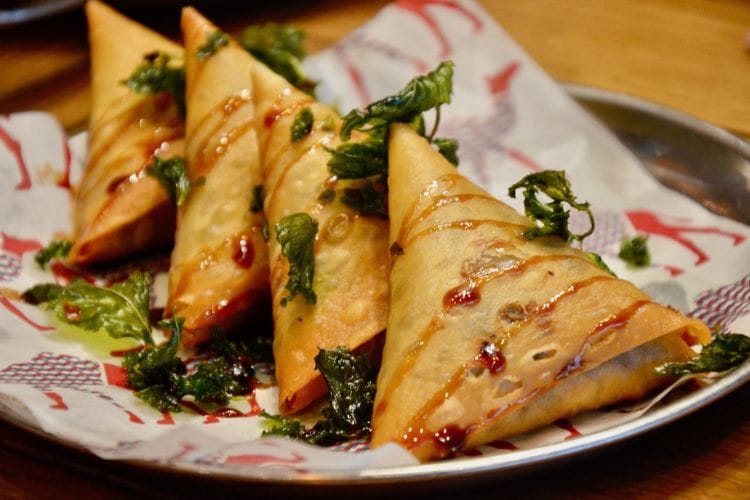
Manakish
Think of manakish as the Middle Eastern answer to pizza. It’s a flatbread topped with cheese, za’atar (a tangy herb mix), or minced lamb. Best eaten hot, straight from the oven. If you’re hanging around Al Rigga, you’ll find bakeries making fresh batches all day.
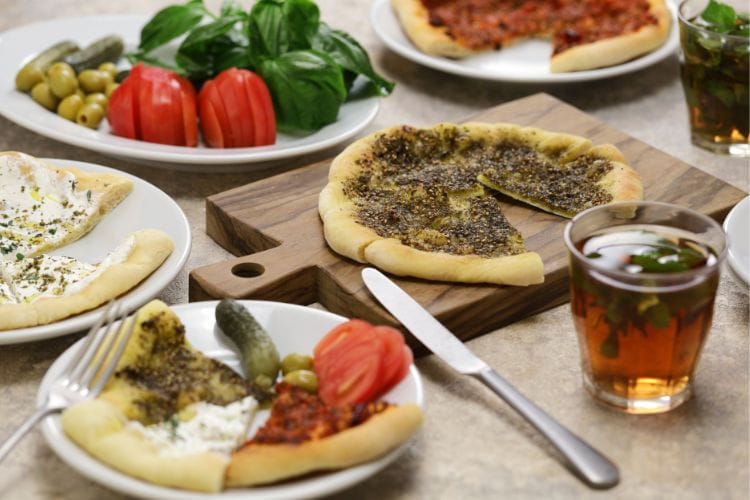
Kebabs
If there’s one thing Dubai does right, it’s kebabs. From juicy seekh kebabs to chicken tikka skewers, the options are endless. Served with warm flatbread and salad, it’s street food but feels like a full meal. Pro tip: Try them at Al Ustad Special Kebab, a Bur Dubai icon that’s been around since the 1970s.
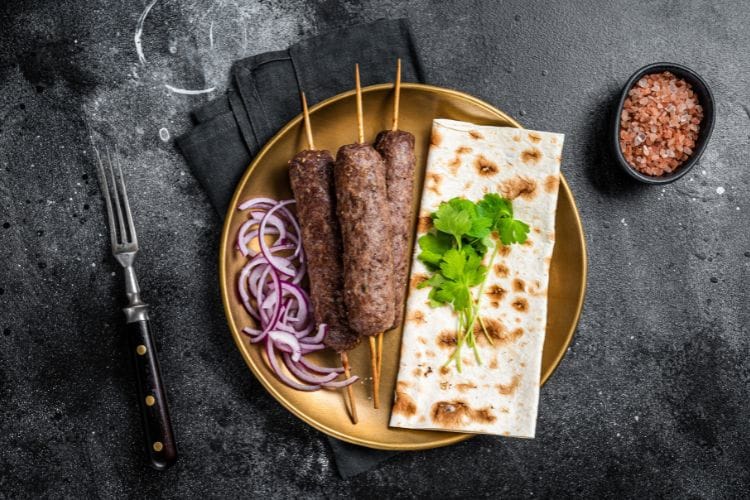
Harees
Now let’s talk about something more traditional. Harees is an Emirati dish made from slow-cooked wheat and meat, almost like a porridge. It’s especially popular during Ramadan. Don’t expect flashy flavors, it’s hearty, comforting, and a true taste of Emirati tradition.
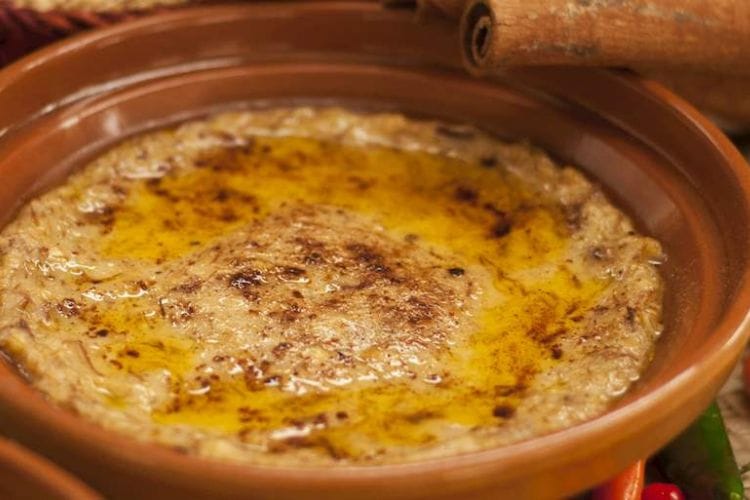
Knafeh
You can’t leave Dubai without trying knafeh. It’s a sweet pastry layered with cheese, topped with crunchy shredded dough, and soaked in sugar syrup. One bite and you’ll understand why it’s loved across the Arab world. Some places even top it with pistachios. Can you imagine that cheesy-sweet combo?
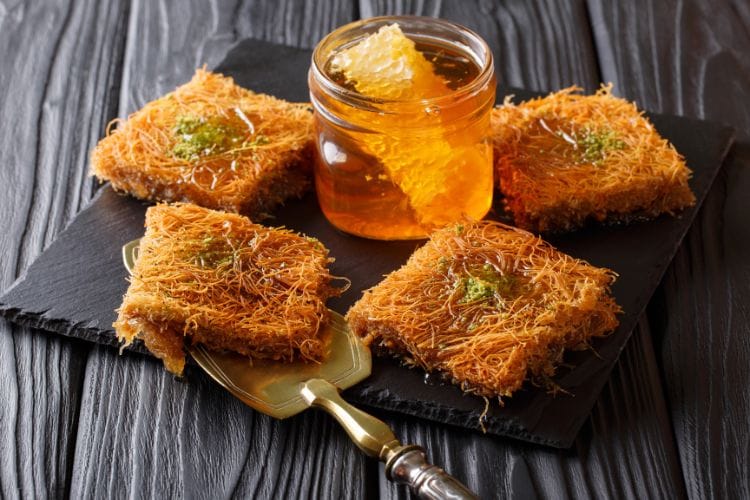
Madrooba
Another Emirati classic, madrooba is made with salted fish, spices, and thick porridge-like consistency. It’s rich, filling, and very local. Not as easy to find at every street stall, but worth hunting down if you want something authentic.
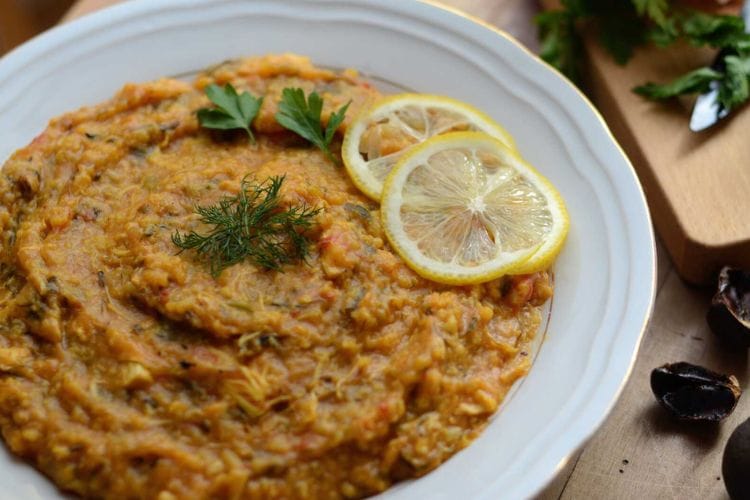
Machboos
Similar to biryani, machboos is a spiced rice dish cooked with meat, saffron, and dried lemon. It’s fragrant, hearty, and often served at family gatherings. Luckily, some traditional food spots also serve it in smaller street-style portions.

Chana Chaat
This one’s for the spice lovers. Chana chaat is a South Asian snack made with chickpeas, onions, tomatoes, green chilies, and tangy spices. It’s sold in little paper plates at Meena Bazaar and Karama. Spicy, sour, crunchy, it hits all the notes.
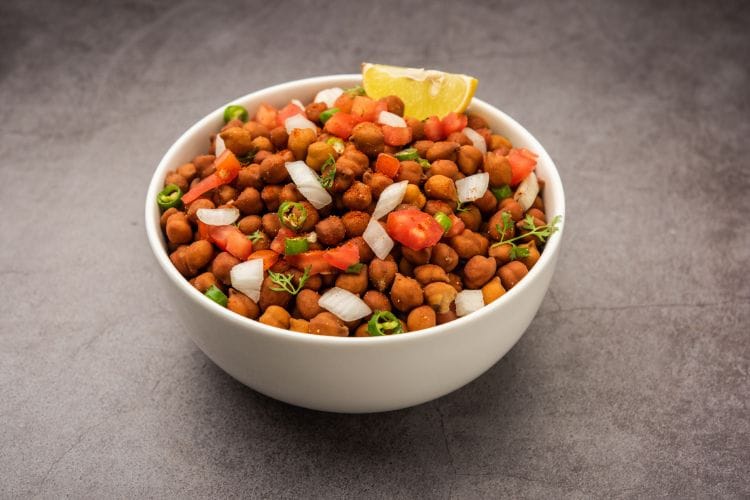
Parathas & Rolls (Aloo/Chicken/Keema)
And finally, parathas and rolls. Imagine hot flatbreads stuffed with potatoes, minced meat, or spiced chicken. They’re quick, cheap, and super satisfying. Food trucks near Jumeirah and stalls in Karama serve some of the best.

Best Street Food Spots to Visit
So, we’ve talked about the dishes. But where do you actually find the best Dubai Street Food? The city is huge, and trust me, wandering aimlessly can feel overwhelming. Don’t worry, we’ve got you covered. Here are some tried-and-tested spots where you’ll find everything from juicy shawarma to traditional Emirati plates.
Al Karama – The Flavor Hub
Karama is basically street food heaven. It’s busy, colorful, and full of Indian and Pakistani eateries that won’t break the bank. Here’s the fun part, you can go stall-hopping here and eat an entire meal for less than AED 25 ($7). That’s starter, main, and dessert. Crazy, right?
Must-tries here: samboosas, parathas, and chana chaat. And if you’re into desserts, look for tiny bakeries selling luqaimat.
Deira – Old Dubai Vibes
Now, if you want that classic old Dubai street food feel, head straight to Deira. This area is one of the city’s oldest districts, packed with shawarma stands, falafel joints, and juice shops. Some stalls here have been running for decades, serving generations of locals.
According to a survey by Time Out Dubai (2024), Deira still ranks as one of the top three neighborhoods for affordable eats. No surprise there, the shawarmas here are legendary.
Al Dhiyafah Road (Now 2nd December Street)
This street is kind of like a mini food festival that never ends. You’ll find Lebanese grills, Iranian kebabs, Indian curries, and even some Filipino snacks. It’s a place where food is cooked right in front of you, and the smells are honestly impossible to resist. Perfect for a late-night food crawl.
Satwa – Old School Favorites
Satwa is another local hotspot, especially if you’re craving Pakistani or Filipino comfort food. It’s also home to the famous Ravi Restaurant, which has been serving affordable curries and kebabs since the 1970s. Fun fact: Gordon Ramsay once ate here and gave it a thumbs-up. Not bad for a casual street-side eatery, huh?
Global Village (Seasonal)
If you’re visiting between October and April, you have to check out Global Village. It’s a huge cultural festival with food stalls from over 90 countries (source: Global Village Official Site). Imagine eating Turkish kebabs, Thai noodles, and Emirati luqaimat all in one night. It’s basically a food passport.
Al Seef & Meena Bazaar
For a slightly touristy but fun vibe, Al Seef is a nice pick. It’s along Dubai Creek and has stalls selling Emirati snacks, karak chai, and grilled meats. On the other hand, if you want proper South Asian flavors, head to Meena Bazaar. The chaat stalls there are spicy, messy, and absolutely worth it.
Jumeirah Food Trucks
Now, if you prefer a beach vibe, Jumeirah is where food trucks park with shawarmas, sliders, and ice-cold juices. The prices are a bit higher than Karama or Deira, but hey, eating a roll while looking at the Burj Al Arab? Worth it.
Quick Tips Before You Go
Here’s something important, local food in Dubai is safe, but you still want to pick wisely. A few tips to keep in mind:
- Always go for busy stalls. If locals are lining up, that’s a good sign.
- Carry a bit of cash. Many stalls don’t take cards.
- Ask about the spice level. Some snacks, especially South Asian ones, can be fiery hot.
- Stay hydrated. Dubai heat + spicy food = not always a fun combo.
- Dress modestly if you’re heading to older districts like Deira or Satwa. It’s about respecting local culture.
So yeah, whether you’re sitting on a plastic chair in Deira with a shawarma, or at a Jumeirah food truck sipping sugarcane juice, Dubai Street Food has a way of making you feel like part of the city. It’s casual, authentic, and honestly one of the best ways to spend an evening.
Conclusion
So, what’s the takeaway here? Well, Dubai isn’t just about glitzy brunches or Michelin-starred restaurants. The real magic often happens on the sidewalks, in the smoky little kebab stalls, and at those tiny bakeries tucked into older neighborhoods. That’s where you’ll find food that tells the city’s story—layered with Emirati tradition, flavored with spices from everywhere
According to Dubai Tourism’s 2024 Food and Beverage Report, more than 45% of tourists say food is a top reason for their trip, and street food ranks among the most memorable parts of their visit. Makes sense, right? You remember a shawarma eaten at midnight more than a pricey five-star meal.

